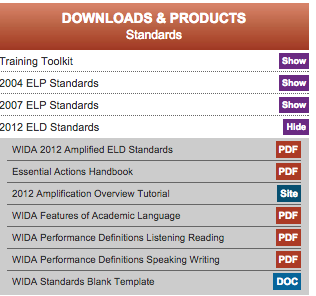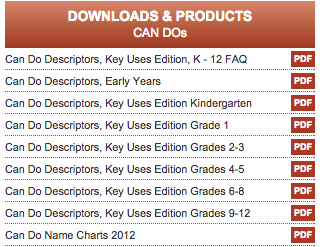ELD Standards
These ELD standards were developed in 2004 by a consortium of states called WIDA (World-Class Instruction Design and Assessment). In September 2011, WIDA released revised ELD standards for 2012 which include “cognitive function” (Bloom’s revised taxonomy). They outline the progression of English language development in the four domains of Listening, Speaking, Reading, and Writing through five levels from novice to proficient. Click on “Downloads & Products/Standards” to go directly to wida.us to be sure you have the most recent version.
- Kindergarten ELD Standards

- 1st grade ELD Standards
- 2nd grade ELD Standards
- 3rd grade ELD Standards
- 4th grade ELD Standards
- 5th grade ELD Standards
- 6th grade ELD Standards
- 7th grade ELD Standards
- 8th grade ELD Standards
- 9-10th grade ELD Standards
- 11-12th grade ELD Standards
WIDA 2012 Amplified ELD Standards: the complete document
Performance Definitions
The Performance Definitions for Listening and Reading and Speaking and Writing provide an incremental overview of the language acquisition process from Level 1 Entering through Level 5 Bridging. These incorporate five language standards in each of the four domains (Listening, Speaking, Reading, and Writing):
- Social and Instructional language
- The language of Language Arts
- The language of Mathematics
- The language of Science
- The language of Social Studies
Features of Academic Language
The WIDA standards chart these Features of Academic Language by proficiency level:
- vocabulary usage
- language forms and conventions
- linguistic complexity
The WIDA writing rubric is also useful for scoring student work in the classroom.
CAN-DO Descriptors
The CAN-DO descriptors give teachers a basic overview of each student’s abilities based on the annual proficiency test (ACCESS) results. Keep in mind that each student will have a separate score for each domain. Generally, Speaking and Listening proficiency develop more rapidly than Reading and Writing, although there are always exceptions.
Guide your lesson planning and foster student buy-in with these Student Friendly CAN-DO Descriptors K-12 for Grades K-12.
Here are the detailed CAN-DO Descriptors Key Uses 2016 from WIDA. Note that the grade level grouping has changed. Instead of Grades 1-2 and 3-5, Grade 1 is now stand alone and there are now new groups for Grades 2-3 and Grades 4-5. Click on “Downloads and Products/CAN-DOs” to go directly to wida.us to be sure you have the most recent version.
- CAN-DO Descriptors Key Uses Kinder

- CAN-DO Descriptors Key Uses Grades 1
- CAN-DO Descriptors Key Uses Grades 2-3
- CAN-DO Descriptors Key Uses Grades 4-5
- CAN-DO Descriptors Key Uses Grades 6-8
- CAN-DO Descriptors Key Uses Grades 9-12
The charts below include a column where you can add student names to the corresponding proficiency level to create a quick class profile of your ELLs. (WIDA has plans to update the Class Charts so they match the revised grade level clusters.)
- CAN-DO Descriptors Kinder Class Chart
- CAN-DO Descriptors Grades 1-2 Class Chart
- CAN-DO Descriptors Grades 3-5 Class Chart
- CAN-DO Descriptors Grades 6-8 Class Chart
- CAN-DO Descriptors Grades 9-12 Class Chart
Here is a set of charts that list one domain at a time for each grade level. There is more room to add your students’ names. CanDo Namecharts with new clusters by domain and grade level.
Model Performance Indicators (MPI)
The Model Performance Indicators (MPI) are examples of language usage from each of the four domains (Listening, Speaking, Reading, and Writing) presented in a developmental sequence across language proficiency levels and grade level clusters. They incorporate the language and instructional supports necessary for English language learners to progress towards mastery of state academic content standards. They include both formative and summative examples. Regardless of the grade level or content area, MPIs for Levels 1,2, and 3 incorporate visual or graphic support, realia, or manipulatives to provide students access to meaning through multiple modalities. MPIs for Levels 4 and 5 assume students are exposed to and working with grade level material. These charts were developed by the NC Department of Instruction:
- WIDA Standards MPIs Kinder
- WIDA Standards MPIs Grades 1-2
- WIDA Standards MPIs Grades 3-5
- WIDA Standards MPIs Grades 6-8
- WIDA Standards MPIs Grades 9-12
Use this tool from WIDA to search the ELD standards for MPIs by grade level cluster, proficiency level, language domain, and topic.
Confused about the difference between CAN-DO Descriptors and MPIs? WIDA makes a clear comparison with this chart:
NC Department of Public Instruction has released a 64 page document on “Unpacking the ESL Standards.” If you scroll through it, you will find good sentence frames that model how to teach ELD standards within each content area.
WIDA Tutorial (video)
Hampton Brown’s “Avenues” Correlations K-5
- WIDA – Avenues Correlation
- Common Core ELA – Avenues Correlation
- Essential Standards Avenues Correlations (based on Dare County Schools Curriculum Maps)
Contact me
I welcome suggestions for other resources to be included in this site. Please use my contact form or email me directly at jessicaloose.obx@gmail.com.

